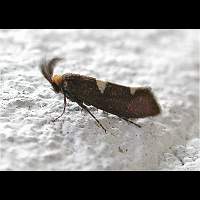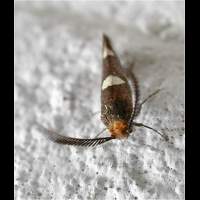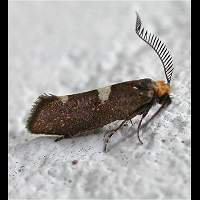Incurvaria pectinea
Incurvaria pectinea is very similar to Incurvaria masculella. There are some differences though. Incurvaria pectinea has its white spots slightly less clearly bordered, the front wings are purplish brown and because of the light hind wings there is a contrast visible between the wings when the animal flies. Incurvaria masculella usually has clearly defined white spots, the front wings are brownish without a purple shade and the hindwings are quite dark. When it flies there is no sign of contrast between front wing and hind wing. The wingspan of Incurvaria pectinea is some 12 to 16mm.
The eggs are being laid in small groups, in May mainly. The newly hatched caterpillars are small enough to mine a leaf. The mines are very characteristic. There may be three to five larvae in just one leaf. When they get too big to live inside a leaf, the caterpillars make round or oval-shaped holes in the leaf. They produce two of these holes, weave them together, sit between the two pieces. Next they drop to the ground, where they continue feeding on debris, regularly making a new sack to live in. The infested leaves have two or more very characteristic holes: round or oval, like it has been punctured. Pupation takes place before winter and it is the pupa overwintering. The caterpillars are white and easily identified by their nice round bag. Incurvaria pectinea's main foodplant is the birch, but it is occassionally found on other trees and shrubs, such as hazel and apple. If it appears in apple trees it is rarely necessary to fight the infest, for damage is limited and numbers are usually very low.
Incurvaria pectinea is single brooded and on the wing in April and May. The species flies by night mainly, but is sometimes seen flying about in daylight. Besides it is easily disturbed when resting. Is not attracted to light, but has been seen resting on walls, fences and leaves. This species is rather uncommon in Southern Engeland, but becomes more common going northwards. A common species all over Scotland.
Incurvaria pectinea is very similar to Incurvaria masculella. There are some differences though. Incurvaria pectinea has its white spots slightly less clearly bordered, the front wings are purplish brown and because of the light hind wings there is a contrast visible between the wings when the animal flies. Incurvaria masculella usually has clearly defined white spots, the front wings are brownish without a purple shade and the hindwings are quite dark. When it flies there is no sign of contrast between front wing and hind wing. The wingspan of Incurvaria pectinea is some 12 to 16mm.
The eggs are being laid in small groups, in May mainly. The newly hatched caterpillars are small enough to mine a leaf. The mines are very characteristic. There may be three to five larvae in just one leaf. When they get too big to live inside a leaf, the caterpillars make round or oval-shaped holes in the leaf. They produce two of these holes, weave them together, sit between the two pieces. Next they drop to the ground, where they continue feeding on debris, regularly making a new sack to live in. The infested leaves have two or more very characteristic holes: round or oval, like it has been punctured. Pupation takes place before winter and it is the pupa overwintering. The caterpillars are white and easily identified by their nice round bag. Incurvaria pectinea's main foodplant is the birch, but it is occassionally found on other trees and shrubs, such as hazel and apple. If it appears in apple trees it is rarely necessary to fight the infest, for damage is limited and numbers are usually very low.
Incurvaria pectinea is single brooded and on the wing in April and May. The species flies by night mainly, but is sometimes seen flying about in daylight. Besides it is easily disturbed when resting. Is not attracted to light, but has been seen resting on walls, fences and leaves. This species is rather uncommon in Southern Engeland, but becomes more common going northwards. A common species all over Scotland.






